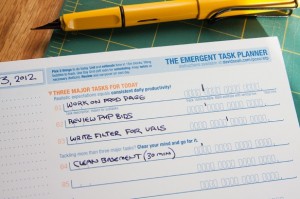Graduate students, researchers, evaluators, and academics (“knowledge workers“) encounter productivity challenges unlike other fields. Productivity strategies that work for most often do not transfer well for us. One primary reason is because knowledge workers are expected to contribute original knowledge. Lots of it. Boosting productivity means learning how to do more of it, in the least amount of time possible. By gaining greater clarity into the nature of knowledge work and principles of productivity, and insights into one’s productivity habits, you can expect to produce more at a high quality, reclaim lost time, while keeping stress down.
Knowledge work requires one to digest a high volume of information, and increasingly, requires close collaboration. Complicating matter is that knowledge work is time-bound: a few months for a project, 2 years for a masters, 4 years for a Phd; 5 years until tenure review for asst. profs… The pressure to produce is real.
At the most basic level, engaging in knowledge work requires one to do three things: Reading + Thinking + Writing.
Productivity matters because performance is hinged upon successes in executing tasks (both in quantity and quality). Grad students are increasingly expected to publish in today’s competitive climate. Tenure decisions are made based on producing a substantial body of works. And of course, for starving grad students, pay is dependent on productivity
Doing more in less time, while maintaining a high quality is not enough. Knowledge work also requires a high degree of creativity and integrative thinking. Being able to free the mind to think in novel ways is as important as being able to play to the rules.
Having finished four years of graduate studies and working in the roles of researcher/evaluator, what have I learned about the nature and demands of productivity?
1. Project work
I’ve learned that much of knowledge work is project-based. Projects have definite start-dates, end-dates, and key deliverables. Some projects are low-stakes (e.g. class assignments), some are medium stakes (RA work), and some are high stakes (e.g. scholarship/grants). It’s important to be able to deliver quality work in all situations.
To be high functioning, we must be able to juggle between multiple projects at once. This requires high-level planning to keep track of project statuses. This means being able to switch between projects. This means recognizing the rhythm to when things tend to get busy in a project, and when things tend to slow down. This means recognizing project bottle-necks.
2. Substantial time horizon
Many of our projects span some significant time. And projects are often put in waiting patterns, like when planes are queuing up to land. Developing a tolerance for waiting is key. Know when to follow-up on projects to give it that little nudge to move things along.
3. Thinking is hard work.
Thinking is a crucial, and obligatory part of our work, but rarely do we give it enough attention. It occurred to me some time ago that there are different kinds of task and each require a different level of engagement.
- Repetitive tasks require little cognitive demand, but demands high accuracy. Tasks like data entry, processing e-mails, searching for literature are of this type.
- Intellectual tasks require some creativity. They usually require some integration or synthesis of information. Most acts of writing are of this type. Qualitative coding is also another example.
- Finally, creative tasks are those that require a high level of creativity, high level of integrative thinking, and high engagement on task. Theming qualitative data, planning writing pieces, and synthesizing literature are examples of creative tasks.
Now, why do we care about these distinctions? We care because creative tasks are those that matter most in knowledge work, but that’s those are the tasks that are most draining. It’s really hard to sustain creative bouts. We have about two hours of golden productivity each day—- allocate these time towards creative tasks!
4. Balancing obligations
Complicating productivity are those obligations that get in the way. Groceries, car troubles, emails, administrative paperwork, etc… Balancing obligations requires one to be mindful about what really counts and what can wait. There’s increasing pushback against checking e-mails first thing in the morning. Create time intentionally to allow you to do tasks that really matter. For grad students and academics, that usually means one thing: publications.
5. Tracking success
Finally, I’ve found that tracking productivity successes to be one of the most important, but least obvious ways of boosting productivity. Tracking successes require us to clarify what success looks like. When we being to track success, we can begin to assess how we actually spent time, how much work got done, and how better to optimize our work. At the simplest level, checking off to-do lists is one way to track success. But what about higher-level success tracking? Productivity tools are really good at planning, but not at evaluating successes. One of the tools that I’ll be introducing tackles this problem.
Now that I have laid the foundation to how I understand productivity, in the posts that follow, I’ll look at how we can tackle each of these challenges. I’ll be introducing some tools and concepts that I have found to have transformed how I work.
How are you finding this article? What productivity challenges are you experiencing? Does any of this resonate with you? Share below. I would love to hear from you.








